responses/reviews
Archived Posts from this Category
Archived Posts from this Category
Posted by ben on 27 May 2008 | Tagged as: responses/reviews
Kriston Capps responds to Tyler Green’s post “Heteronormalizing Robert Rauschenberg,” defending his own omission of Rauschenberg’s sexuality in the Dallas Morning News. Be sure to check Green’s response in the comments.
Posted by ben on 19 May 2008 | Tagged as: r.i.p., responses/reviews

I decided not to post on the death of Robert Rauschenberg because I figured everyone else would. (That’s the attitude that has led to me posting only twice in the last three weeks. Sorry about that, folks.) But I would like to draw your attention to Tyler Green’s post on arts writers all over the country eliding Rauschenberg’s homosexuality, despite its centrality to his work.
Posted by ben on 23 Apr 2008 | Tagged as: performance art, responses/reviews, video/film
I have a piece in last week’s Current discussing the work of Regina José Galindo (currently at Artpace). It’s not so much a review as a discussion of the history of Galindo’s work, and the way that it brings protest strategies into a visual art context. There’s a lot I couldn’t get to in that article, though, and thought I might dig into that a little bit here.
One thing that struck me about the work at Artpace is the contrasting uses of performance and documentation by Kate Gilmore, Regina José Galindo, and Margarita Cabrera. (Although Rodney McMillian incorporated performance and documentation into his work, for various reasons I won’t be discussing him in this post.) Galindo’s performance draws from a protest tradition — at Artpace, she locked herself along with her husband and daughter in a mobile prison cell in the gallery. Also, like a protester, she views her performances as her artwork, while the videos and photographs that are generated from them are purely documentation of the performance — not individual works of art, but necessary to spread “word of the performance and the message.” However, when she discusses her intentions and expectations, Galindo never mentions social change:
I suppose that—like everything I do—this was done for me…. I never have any expectations after completing something. What I do have is a certain amount of nervousness and anxiety before every performance. But after that I have no expectations. It’s done.
So in this way at least, it is distinct from protest which aims to catalyze social change.
Like Galindo, Kate Gilmore puts herself into dangerous or difficult situations in order to comment from a personal perspective on the systemic problems that prevent human progress. But the similarities end there. Gilmore’s work consists of performances on video (the videos being, in this case, the artworks, while the performances become simply part of the process of creating the work). The situations Gilmore puts herself in don’t target material injustices, but are created by the artist. She sets her foot in a bucket of cement, lets the cement dry, and then sets about the task of breaking her foot out of the cement with a hammer. This kind self-imposed task suggests an allegorical confrontation with psychological barriers more than a way to address specific injustices (although these barriers are connected to societal inequities).
Margarita Cabrera takes a different tack. She turns the gallery space into a makeshift copper butterfly factory, and recruits community volunteers to make 2,500 butterflies by hand. This strategy recalls the work of Harrell Fletcher, who often addresses divisions within communities by organizing collaborative events. However, Cabrera does, like Galindo, deal with concrete issues of ongoing social injustice. The workshop Cabrera builds is meant to signify the maquiladoras (low-wage manual labor factories, often with lax labor law enforcement) in Mexico. By “exporting” the butterflies to the home of a wealthy San Antonio collector, Cabrera targets economic systems that hide the human costs of a product from its owners by separating the craft from the craftsman. The documentation plays a minor role in this work: a photograph of the butterfly installation is affixed to the wall of the workshop. In another parallel to Galindo’s work, Cabrera leaves the workshop for gallery visitors to explore, so that a trip to the gallery gets you an experience of the residue of her artwork.
The interplay between these exhibits helps flesh out the contours of performance in contemporary art. Each artist works with performance strategies that articulate a distinct relationship between artist and community. By placing these shows side-by-side, Artpace encourages the visitor to contemplate approaches to social critique: The direct, literal commentary of Galindo, or the allegory of Gilmore. The interpersonal relations of Cabrera or the personal goals of Galindo. The roles of document and sediment in the artistic process.
Posted by ben on 14 Apr 2008 | Tagged as: arts organizations, borders, politics, responses/reviews
There have been a few little dust-ups in the art world lately regarding conflicts of interest among art critics. Edward Winkleman has the skinny on a feud between art critics Tyler Green (of Modern Art Notes) and Christian Viveros-Fauné (formerly of the Village Voice). Green likes to split his blogging time between criticism and more journalistic pursuits, such as scooping the big papers on the departures of major museum directors. He also likes to call out arts writers for lacking journalistic integrity. After Green pointed out that Viveros-Fauné is a director of the Volta art fair, and an organizer of Chicago’s Next art fair, Viveros-Fauné was canned from his Village Voice position over what was seen as a conflict of interest. Of course, Viveros-Fauné then accused Green of being a self-promotional wanker (spelling Green’s name with an extra ‘e’, presumably to thank him for leaving the accent off Viveros-Fauné in an interview published on Modern Art Notes).
Now this battle has broadened a bit (the comments on Winkleman’s post give a good idea of the range of opinions), and people seem to be dividing into two camps: art critics should follow journalistic standards; or art critics should do whatever the hell they want, they will be judged according to the quality of their writing, period.
When it gets down to it, the art community is entering a phase of commercialization that makes this a very difficult issue to address. As more money flows into the contemporary art world, and as people start to see art as more of a financial investment, the problems that Tyler Green addresses become much more important. Investors want transparency and high ethical standards. However, this commercialization has met with resistance in some quarters, among people who feel that art should be free of the taint of commerce as well as the kind of compartmentalization that these ethical standards often bring.
Artists want to be free to write about art, open their own art spaces, curate shows with artists they respect (often their friends) and ultimately participate in the art community on multiple levels. Everyone who writes for this blog, for instance, also produces art, and two of us have directed gallery spaces while writing about art. The idea of keeping these functions totally separate is, for many of us, antithetical to the freedom and openness that art allows.
So where do I stand on this? Well I’ll just say that I think it’s a good debate to be having. But before addressing the ethical issue per se, we need to clarify our positions on the relationship between art and money. To the extent that art is a commercial endeavor, Tyler Green is right: we need clearly defined roles that prevent conflicts of interest. To the extent that art is about investigating new ways of seeing the world, these roles have the potential to trap us in an overly calcified artistic space.
Update: Tyler Green comments to clarify that he does not see this as a feud between himself and Mr. Viveros-Fauné.
Posted by ben on 29 Mar 2008 | Tagged as: essays, responses/reviews
The Guardian recently featured a piece by David Hockney in which he claims that the decline of the church is directly connected to the democratization of imagery. It’s true that religious institutions have a history of trying to control the kinds of images people create and see, and I’m sure their reasons for doing this have to do with maintaining their grip over people’s minds. But I think you could make virtually the same argument about the church’s control of music, sexuality, history, poetry, or any number of creative ventures (hmm… is history a creative venture?). And this is why Hockney gets it wrong when he says “the power is with images, not art.” The implication here is that power flows from the material truth of the camera, not from the spiritual truth of a work of art. In the past I have quoted Camus making the point that freedom is predicated on the creative act, not production, not representation. This is why churches have tried, and still try, to control creativity — and why their control of material wealth is ultimately secondary to their control of the spirit.
Posted by michelle on 17 Mar 2008 | Tagged as: art paparazzi, responses/reviews
Pretend today is hot potato news day, just snippets of incongruent information:
A little bird told Emvergeoning that Sterling Allen just won an Artpace Residency for the year 2009..Old friends from the San Francisco Noise Scene, win the Best Use of a Flute at South by Southwest for 2008… Zane Lewis might be moving to a place called New York City this year…One of Texas’ star curators, Regine Basha, will be bringing the sound art of Steve Roden and Stephen Vitiello to Ballroom Marfa next year. There was a good article about their West Texas field recordings in the February issue of Modern Painters, only available in print version for now. Buy a copy and you will find a review of Michael Smith at the Blanton while Kate Green writes about at her former place of curatorial business, better known as Artpace.
In other news, the SA Art League mildly mislead artists in thinking there was a lump sum award of $5,000 for their annual call for entries. And despite grumblings amongst local artists, Toby Kamps, Senior Curator at the Contemporary Arts Museum Houston confirmed with Emvergeoning that every piece in the upcoming show was cherry picked by himself, not the Art Leaguers. Apparently most of the award money has been divided between 20 or more artists from San Antonio [myself included]. No official list of artists has been released and the amount of each award is clandestine until the show opens April 6th. Still, I think it might be enough to
Also, speaking of the CAM in Houston, recent Artpace Resident Allison Smith will be in a group show beginning in May called “The Old, Weird America.” Shouldn’t it be Ye Olde Weird[e] America? Emvergeoning minds want to know.
Posted by michelle on 17 Mar 2008 | Tagged as: responses/reviews
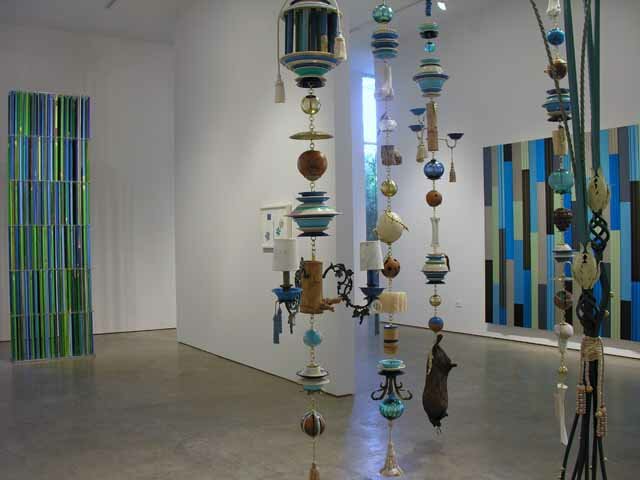
Thomas Glassford indulges in anodized aluminum, found objects and framed zippers at his latest solo show in Houston this month. The show, “Between Earth and Sky” at Sicardi Gallery, just closed on March 15th. Glassford strikes two different chords that balance pitch perfectly in the gallery. The giant, chandelier-like structure titled “Dark Eyes” piques visitors attention with an assortment of stacked dinnerware, ornaments, gourds, skeletal remains and fluffy clean sponges. Upon closer inspection, a lamp fixture lets viewers peek into a child’s private world with pint size lampshades covered in crude drawings of fatuous mazes, little round devils and poor penmanship. There’s something flawless about Glassford’s approach to anodized aluminum. His series of Paritituras seems to have found a new rhythm, with cerulean, grey and verdant aluminum panels arranged as shuffled piano keys in “Between Earth and Sky.” A tower of discarded broom handles in lovely weathered blues and greens seems to pay homage to invisible labor and the accumulation of time. In a small, framed mixed media piece, “Don’t touch Me,” the artist puts an elbow patch, a blue/gold zipper and some glitter flower appliques in an arrangement that seems separate but equal. Glassford pulls a mimetic line from the aluminum panels and into the small delicate frames with clean lines of mint condition zippers seemingly holding ground between celestial ideals and earthly delights.
Next: How Artist Draw at the Menil
Posted by ben on 16 Mar 2008 | Tagged as: arts organizations, possibilities, responses/reviews
I’m still collecting thoughts and reactions from Luminaria, but here’s my initial post-event take on how it all turned out. While a lot of my pre-Luminaria criticisms still stand, I think these problems need to be put into perspective. First of all, I think for most people who made it downtown (and there were a lot of folks out there), the organizational problems were not really apparent. The events flowed well, there was a lot of good energy and big crowds, but it was never difficult to get to where you wanted to be, and there seemed to be plenty of strategically located food and drink stands, port-o-potties, etc. The event planners and promoters did their job, and everyone I talked to seemed to really enjoy the night.
As expected, there was a pretty big range in both the style and the quality of art presented. As I pointed out earlier, I think Luminaria could benefit from more competitive funding opportunities. I’d like to see a process in place that would allow museum-quality artists to create new work specifically for Luminaria — site-specific installations, sculptures, projections, etc. There’s no way this will happen unless a bigger chunk of money is available to participating artists. But I also think Luminaria needs to keep the inclusive feel that was achieved last night. Things felt very open, with the symphony playing across the street from fire dancers and around the corner from an open-mic poetry reading, work by Chuck Ramirez and Katie Pell across the street from student art.
One criticism I made earlier was that the city didn’t try to build on existing, grassroots art events like First Friday or Contemporary Art Month. Last night I realized why this would have been a bad idea. Luminaria is really a different beast from these events, which mostly rely on independent venues to do their own thing, and have very little central organization. But at the same time, these existing art events have a lot of interested parties who would probably feel that the city was hijacking their event. Luminaria needed to start fresh, and put something together that isn’t identified with a singular community, but represents the diverse artistic talents that exist throughout San Antonio. And they also needed to be able to have a strong, central organizational structure that these other events, for the most part, lack.
Overall, I think Luminaria was clearly a successful event, with plenty of room for improvement. Many of San Antonio’s best artists were not represented, but I think people got a good sense of the diversity and energy that exists in San Antonio’s artistic communities. And the city spared no expense on capping it off with a great fireworks display off the roof of the Emily Morgan.
We’ll be posting some photos later this afternoon. Stay tuned…
Posted by michelle on 09 Mar 2008 | Tagged as: responses/reviews

Emvergeoning hit Houston this weekend, with stops at Sicardi Gallery, Blaffer Gallery, the Menil Collection, Lawndale Art Center and a couple of private collections. I’ll cover each destination individually…
Lawndale Art Center
We cracked open the notebook with the a Fotofest show at Lawndale Art Center, featuring Hana Hillerova, Austin-based photographer, Adam Schreiber and Houston-based photographer Chuy Benitez. Though it was meant to be a photocentric installation, Hillerova pulled photos into crystal visions that stemmed from her diamond piece de resistance at Sala Diaz just last year. The photo collage [pictured above] was one of two small pieces that seemed dwarfed by the scintillating, mirrored glass sculptures that stretched nearly 20 feet high.
Benitez captured some absurd Mexican American cultural moments like the starstruck looks of an audience viewing Our Lady of the Baking Pan or a group of young, well groomed mariachis serenading customers at a check out stand in a Fiesta Supermarket. He took a series of portraits of artists and activists in Houston’s thriving Mexican American community. The diptychs bulge at the sides with an unflattering fish eye lens approach. They almost need a timpanist accompaniment for the full, comedic effect.
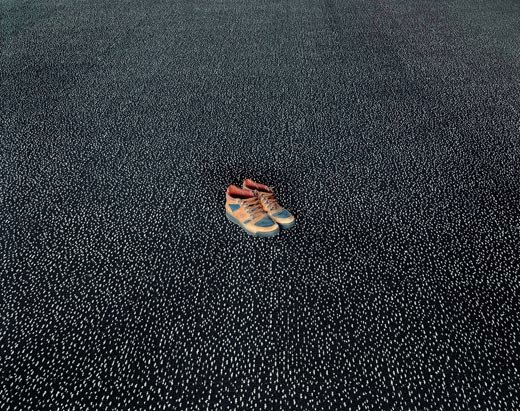
Adam Schreiber captured the sterility and seeming hyper reality of clean rooms, presidential toothbrushes and filthy, forgotten corners of dormant military compounds. Here’s an example of a star system covered carpet infiltrated by the artist’s sensible walking shoes.
In the project space on the top floor of the Lawndale, William Stewart made a meta photo out of smaller photos of the 3rd Ward in Houston. Prima facie, all the photos seem to come from an eye attracted to hand painted signs and dilapidated structures. With places called “Scientific Cleaners” and “Ardream Restaurant,” Stewart’s photos are simple and sincere in their dual function of documentation and admiration for all things overlooked.
Next stop: Thomas Glassford at Sicardi Gallery.
Posted by ben on 07 Mar 2008 | Tagged as: announcements, essays, responses/reviews, sneak peeks, video/film
The new issue of Art Lies should be hitting your favorite news stand soon; but they already posted it online, including my review of the Triangle Project Space tps show Standing on one foot, and an interesting conversation between San Antonio’s Potter-Belmar Labs (Leslie Raymond and Jason Jay Stevens) and Oakland’s Double Archive (Chris Kubick and Anne Walsh). Enjoy!
Posted by ben on 27 Feb 2008 | Tagged as: books, ceramics, essays, responses/reviews

This is the first half (or so) of Garth Clark’s Subversive Majesty: Peter Voulkos’ Rocking Pot (included in , his brilliant book on ceramic art):
Rocking Pot is inarguably one of Peter Voulkos’ most inventive and important works. Its strength comes from its intense mixture of ambiguity and ambivalence. Its form is perplexing because it seems familiar; a relative of the domestic pot. Yet its self-penetration of volume and its strange base, made up of two curved feet or “rockers,” sows confusion and challenges its claim to vesselness. It presents itself simultaneously as a pot, a sculpture, and a demented birdfeeder. But Voulkos has no such confusion about the piece. Unequivocally he has stated, “I claim this as a pot.”
That, then, should be the last word on the subject. But in the world of ceramics there is a curious tendency to “upgrade” pots to sculpture when they project the energy of art, as though the pot is too lowly a medium for higher levels of expression. Obviously this is often at the hands of critics who have not spent any time with a Ming vase or a Mimbres bowl. But this elevation to sculpture is meant to be a compliment to the artist (albeit backhanded), and undoubtedly this is what Rose Slivka intended when she described Rocking Pot as “one of Voulkos’s earliest outright sculptures. The pottery technique is evident, while the pottery function is subverted to the formal invention.”
This statement perhaps best reveals the core misunderstanding among the fine arts in the (under) appreciation of the dynamism of pottery. Pots do not cease to be pots when function is subverted. Indeed, for millennia, denying function has been one of humankind’s ways of setting aside certain vessels for a different role, one that perforce became ritualistic and contemplative. Sometimes the act of removing function was profound, as in the Mimbres culture’s practice of putting a hole into the bottom of bowls of the deceased, to allow their souls to escape into the spirit world. This precluded domestic/utilitarian ideas of containment in favor metaphorical containment, in this case a purposeful permeability. In other cases function was obscured rather than denied for reasons of whimsy — to tease the user, as with the so-called puzzle jugs and mugs of the Medieval period.
What supports Voulkos’ insistence that this object be seen as a pot is that it becomes more intriguing when viewed in ceramic terms rather than from a purely sculptural viewpoint. The act of cutting holes into an abstract sculpture is primarily a formal act. Cutting holes into a pot is a violation. It upsets orderly notions of utility and culture. In pottery, volume is a sacred space. Holes deliberately placed by the potter provide entrances and exits. But when punctured in the seemingly destructive and random manner of the Rocking Pot, the vessel can no longer serve its literal purpose of containment. By further skewering the interior of his pot with his curved rockers, Voulkos adds an edge of surreal spatial violence.
Violence against the vessel, however, was not Voulkos’ goal. If the sanctity of the pot has been bruised, it is simply because it has come up against the intense energy and physicality with which the artist imbues his vessels. The holes serve many purposes in this piece. On one level they are drawings in three dimensions (much like Lucio Fontana’s paintings and sculptures from his Concetto Spaziale series). One may even view them more conservatively as pottery decorations in their most abstract form. But they are also spy-holes into the interior architecture of the vessel. They reveal the pot’s powerful inner structure, which those who admire pottery as an art already know exists, but few have seen exposed in so visceral a manner.
Posted by ben on 18 Feb 2008 | Tagged as: announcements, borders, politics, responses/reviews
Some of you may have been a bit surprised to see Emvergeoning turn into a platform for a political campaign yesterday (I must admit I was a bit surprised myself, despite my own flirtations with political themes). Yes, the contemporary art community in San Antonio seems to be coalescing around Obama’s campaign, but what does this really have to do with the artistic project, especially considering our previous criticisms of politically driven art?
Let me try to explain why this presidential campaign is relevant to Emvergeoning’s overall mission. In a nutshell: we are here to open up the dialog that exists within the San Antonio art community, to help draw new voices in, both from the local community and from distant cities. We want to bring more people into the conversation. This is, I think, exactly the kind of change that Barack Obama is offering America: to break down barriers in the dialog. No, he’s not going to instantly launch the United States into a post-racial, post-partisan social dynamic. No, he’s not going to end corruption and corporate influence in Washington. But Obama does represent our best chance to mollify the cynicism of our political discourse, and move partisan bickering a little closer to sincere and honest dialog.
As an example, look at Obama’s strategy while working to expand health care options in Illinois. As reported by health care expert Jonathan Cohn in the New Republic, Obama worked to build a coalition of health care activists, doctors, and hospitals, while holding direct talks with insurance and business lobbyists. Because he brought all interested parties on board as he crafted a health care task force, “He could not be accused of partisan aggression. But he got his way,” according to John Bouman, director of the Shriver Center on Poverty Law.
Contrast this approach to Hillary Clinton’s when she headed the Task Force on National Health Care Reform created by then-president Bill Clinton. The task force’s members and meetings were kept secret, so that by the time the plan was unveiled, the task force had already been sued for violating regulations related to government transparency. Meanwhile, a number of fellow Democrats crafted their own, competing health care plans, while conservatives and business interests lined up an intense PR campaign to kill the idea.
These episodes exemplify the approaches of the two Democratic candidates, one of whom works closely with both allies and opponents to build consensus through open dialog, and one of whom works within a tight political network to push things through. It could be argued that Hillary Clinton has learned her lesson from her health care debacle, if it weren’t for her campaign’s use of some of these same kinds of tactics in this primary season. Her insistence on seating the delegates from Florida and Michigan after agreeing with the Democratic National Committee’s decision to strip these states of delegates smacks of cynical political manipulation, and threatens to create an enormous rift within the Democratic party.
I don’t have much hope that Obama will be able to live up to all of his soaring rhetoric; but I do know that that rhetoric is supported by a strong record of good judgment and open discourse. Unfortunately, the same cannot be said of his opponent. It is for this reason that I see Obama as a candidate who is aligned with the goals of Emvergeoning, goals that I think are also central to the task of contemporary art.
Posted by ben on 29 Jan 2008 | Tagged as: responses/reviews, tv
The American Prospect is hosting a dialogue on The Wire between some young political, cultural, and arts journalists. It’s much more probing than my recent post on the show, and if I hadn’t already watched through episode 7, I would think they are being a bit hard on it (they have only watched through episode 3). But the fact is, the show is descending into caricature, and with only three episodes to go, I don’t see much chance for redemption. I’ll explain more when the episodes actually air, but I think the problems with season 5 are summed up pretty well by the TAP crew (they just don’t realize yet how ridiculous it becomes).
One point that some of their commenters make is that since these are all journalists writing about the show, they find the newsroom dynamics to be lacking in subtlety, but those of us who haven’t worked in a newsroom find these interactions much more interesting. This sounds about right to me. It’s also worth pointing out that the “evil bosses” butting heads with the “virtuous editor” in the newsroom is not so different from interactions between McNulty and Rawls in the first season. McNulty wasn’t revealed in all his self-destructive, egomaniacal glory until pretty far into the first season. But I think we also need to face the fact that the show hasn’t been quite as subtle or complex as people make it out to be. This isn’t great literature, although it certainly raises the bar for TV dramas.
Finally, there’s been some discussion of “meta commentary” as The Wire becomes flatter and more caricatured. Is it possible that David Simon and Ed Burns are intentionally commenting on their own professional need to pull in viewers, much like the boss at the Sun who is obsessed with the “Dickensian aspect” of everything? Well, maybe. There is an episode called “The Dickensian Aspect” (episode 6); and, as Spencer Ackerman says, “consider that all our disbelief, objections and disappointments are voiced by Bunk. This is a big tell. Bunk stands in for the audience, thereby suggesting that we’re in for some serious misdirection.” I guess we’ll see. My feeling is that if this is true, after seven episodes The Wire’s writers have gone way too far down the rabbit hole of self-awareness and popped out on the other side: navel-gazing self-absorption. Alternatively, David Simon and Ed Burns aren’t quite as brilliant as everyone makes them out to be, and perhaps face real pressures from HBO that constricts their ability to effectively use the considerable talents they do have.
But I still can’t wait to see the final showdown between Omar and Marlo.
Posted by ben on 24 Jan 2008 | Tagged as: music, responses/reviews, sound art, video/film
Argentine artist Jorge Macchi has been all over South Texas lately — he was a resident at Artpace in 2005, he currently has a piece in the Triangle Project Space’s Standing on one foot, and the Blanton is showing Anatomy of Melancholy, his first “comprehensive U.S. exhibition,” through March 16.
As I wandered through the Blanton exhibit, I was reminded of the scene in The Breakfast Club when Allison (the “psycho” girl) puts on makeup and everyone realizes she’s a fox. Jorge Macchi has put in a lot of effort giving Fluxus a shave and a haircut, and what do you know, it fits very nicely into a standard gallery format. Macchi’s Caja de música, for instance, draws on the chance operations that ’60s experimentalists picked up from John Cage. Taking video of cars on a 5-lane highway, Macchi assigns a musical note to each lane, and as a car enters the frame the note corresponding to the lane it is in plays, creating a kind of randomized music box (you can watch this video on his site).

He’s also very fond of finding the edges of things, the demarcations, and focusing on those rather than the intended content of an appropriated work. For instance, at his Artpace residency, he took the final moments of several old movies and created video loops of the “The End” sequences. In an analogous move at the Blanton show, he cuts everything out of a map except the graveyards. These pieces draw our attention to the liminal moments, the insecurity of transition. Despite the summoning of these precarious situations, though, Macchi’s work feels very comfortable. He’s taken the ideas pioneered by Dada and Fluxus artists, art based on the awkward and the random, smoothed out the edges and made it feel very safe within the white walls of the museum.
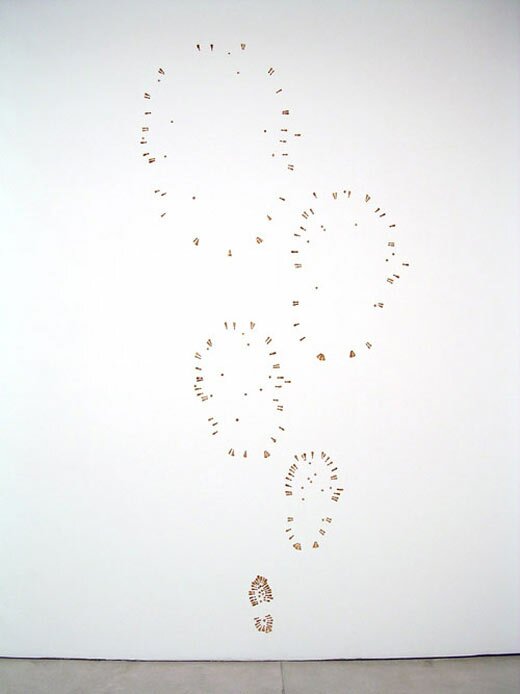
There are some very elegant pieces in the Blanton show, including Caja de música, and Fuegos de artificio, a piece in which footprints made of soil expand outward on the wall, progressively losing their form like ripples on a pond. This is a concise and beautiful statement about the impact we have on the world as we move through it, bringing with us the dirt of another place, which gradually loses the significance of having come from our shoes.
But I’m left wondering whether the ideas Macchi draws from are best expressed with the sort of finesse and refinement he brings to them. Maybe the chance operations of Arp, Cage, Maciunas and all the others are better left in a raw form. Maybe Allison was hot without the makeup.
Posted by ben on 18 Jan 2008 | Tagged as: responses/reviews, tv
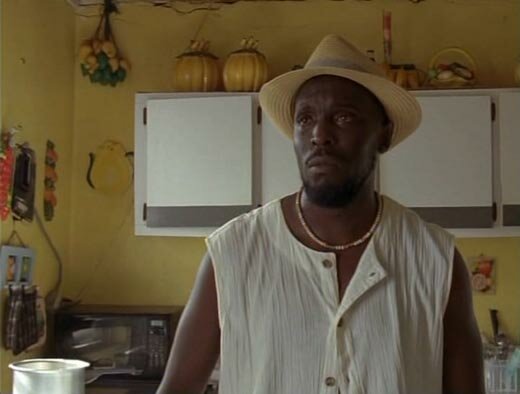
[The following post is about Episode 3, Season 5 of The Wire, and contains some pseudo-spoilers. Nothing very important is revealed, but you might want to hold off until you've seen the episode if you worry about things like that.]
This may be a bit hasty, but I can’t help thinking that The Wire is in mid-jump over the proverbial shark (and apparently at least one or two people agree with me). What I’m thinking of primarily is McNulty’s attempt to create a serial killer out of thin air in order to scare up some funds for the BPD. In Episode 2 I was willing to roll with it, since “the smartest guy in the room” is apparently spiraling into full-on alcoholism. But now they have the imminently reasonable Lester Freeman buying into the plot. And to top it all off, Omar surfaces in some unnamed tropical paradise, while Marlo heads down to the French Caribbean so he can see his money. I’m withholding judgment until Episode 4 makes it to the torrents, but I don’t like where any of this is going. Happily, the dynamic in the mayor’s office and in the newsroom at the Sun is pretty solid so far (although I’m a bit wary of this Jayson Blair-type business developing at the Sun).
Of course, my concern comes with some caveats (as if I hadn’t hedged my shark-jumping proclamation enough in the first paragraph). The Wire is one of the best shows I’ve ever seen, and the writers have done a terrific job of weaving together complex plot lines without straining the characters through four seasons. With McNulty in particular they’ve flipped the script on me in the past — through most of the first season I thought McNulty was a glorified McGarnagle, and that assessment turned out to be dead wrong. So here’s hoping The Wire’s writers have a plot twist up their sleeves that elegantly resolves all my worries and cements the show’s reputation as “best ever.” But if they don’t, I think Episode 3 will be seen as the moment everything started falling apart.
Posted by ben on 08 Jan 2008 | Tagged as: design, essays, graffiti, responses/reviews, wordy
There’s a study making the rounds which investigates the connection between cultural consumption and social position. The findings are being trumpeted as “There’s no such thing as a cultural elite” — but this is a bit misleading. What the study finds is that first, cultural proclivities are determined by social status rather than social class (i.e. it’s more about your education and occupation than your tax bracket). Second, people tend to either seek out popular culture, or to seek out both popular and “high-brow” culture. The interesting point here is that there is no statistically significant group that pursues high-brow culture while shunning low-brow culture. So, for the most part, people are either passive consumers of culture (or “univores”), soaking up the popular types of music, theater, and art that surround them, or they are active consumers (or “omnivores”), spending time and energy pursuing the more rarefied art forms, while also enjoying the arts of the common man.
However, as the study notes, this “univore-omnivore” distinction gets a bit murky when it comes to the visual arts (there’s also another paper by the same authors that focuses specifically on the visual arts). If you clicked on the link at the beginning of this post, you probably noticed that the article in the Toronto Star suggests that the study finds that “the visual arts do not figure very high on anyone’s to-do list.” This is where things get complicated, and naturally, where the journalist gets lazy. The survey the study is based on asked about 6,000 people in Britain what kind of cultural events they attend, including things like rock concerts, jazz concerts, operas, movies, gallery openings, etc. In the visual arts, all five categories boil down to the question: how many museums, galleries, or art / craft fairs have you attended in the last 12 months? Those types of events that could be classified as popular (craft fairs and cultural festivals) actually received much lower attendance than those classified as high-brow (museums and galleries), and thus the “univore” group doesn’t really apply in this area.
The authors of the study also admit that they don’t have any data on home or street consumption of visual art (paintings, posters, graffiti, advertisements, or coffee table books). In a footnote they point to showing that in the working class home, most visual objects are either mementos or decorative objects, both of which are taken as “not artistic.” I think at this point we can begin to see the problem with these findings. Popular forms of visual art are practically defined out of existence, as cinema is grouped with theatrical arts, and all the graphic design, architecture, and other “decorative” elements that constantly surround us are taken to be something other than art. There are numerous ways to engage in visual culture besides going to galleries, museums, and craft fairs, none of which are captured by the dataset used for this study.
Posted by ben on 31 Dec 2007 | Tagged as: art paparazzi, celebrity sightings, responses/reviews

Back in June I noted that Nick Ut had taken the photo of Paris Hilton (above, right) exactly 35 years after the photo of Kim Phuc (above, left), to the day. Today I came across an article in the Telegraph (via Conscientious) which quotes Nick Ut comparing his relationship to the two photos:
It’s a strange feeling because I know I will never take another photograph that’s as good as this – not as long as I live. When I look at my photograph of Kim and my photograph of Paris Hilton, I think they are both good pictures, in their way. I suppose the big difference is that I grew to love Kim, whereas… well, frankly, I don’t give a damn about Paris Hilton.
Not too surprising, really, considering Ut saved Kim Phuc’s life, and to Paris Hilton he’s just another paparazzo. The Telegraph article uses the strange relationship between these two photos to illustrate changes in culture and the role of photography. The premise is that due to both market forces and government regulation, photographers are increasingly pushed towards a minute but distorted documentation of celebrities and away from realistic documentation of international conflicts. More Britney Spears, less Iraq war.
This reminds me a bit of the Nan Goldin exhibit up at the Museum of Fine Arts in Houston right now. There’s a tension in her work between the intimate, gritty realities of chemical and sexual dependency, and stylistic tropes that transform these realities into fantasies. It feels as if she started out as a war photographer, throwing herself into dangerous, chaotic situations and documenting them; but has unwittingly become a servant to the pastime of voyeurism. But I guess the line between truth teller and entertainer has never been terribly clear.
Posted by ben on 28 Dec 2007 | Tagged as: responses/reviews, wordy
A recent post by Edward Winkleman (via Conscientious) responding to an article in The Art Newspaper asks whether artists have a “responsibility to participate in the political debate” through their work. I dealt with this issue back in March, but it’s a complex topic that I’ve had a few more thoughts about since then.
Ed Vaizey’s article in The Art Newspaper asks why we don’t see more artists engaging with political topics from a right-wing viewpoint. Where’s the outrage, he wonders, over the hunting ban (this is a UK newspaper) in the arts community? After all, he figures, contemporary artists tend to be individualists who participate in the market, so why aren’t they more critical of leftists, who tend to restrict individual liberties and free markets? Assuming Vaizey’s characterization of artists as individualistic free marketeers is not a silly stereotype derived from a strange combination of Clement Greenberg’s writings and Sotheby’s press releases, I’m not sure why Vaizey feels that these values would lead artists to care about fox hunting. Unless, of course, he thinks that for anyone to engage in the political debate they have to buy into the expedient left-right dichotomies politicians cram down our throats.
And herein lies the problem. When people talk about an artist’s “responsibility to participate” in political issues, they are asking for engagement in a framework that is both rigid and constantly shifting. What I mean by this is that it is expected that if you support tax cuts, you should support the invasion of Iraq, and if you supported the invasion of Iraq, you should support “enhanced interrogation” (i.e. torture). On the other hand, if you support legalized abortion, then you should support gun control, and if you support gun control, you should support national ID cards. And yet the terms of the debate are constantly shifting; conservatives don’t like big government, unless George Bush wants to expand the Department of Education budget by 50%, or conduct warrantless wiretapping.
So, to come back to Vaizey, if an artist wants to sell artwork on the free market, then why doesn’t that artist oppose hunting bans, and furthermore, show some paintings making that position clear? Participating in the debate means accepting the terms of the debate, rather than critiquing them. Vaizey’s a Conservative politician, but this applies equally to those pushing for artistic activism on the left. Winkleman’s response is a little more reasonable, although I find fault with his implication that the proliferation of more right-leaning art would force those on the left to make political artwork which is more nuanced and universal. If anything, I think it would polarize the art world along the silly, manipulative lines of the political spectrum.
But I think there’s also a much more concrete, practical problem with calls for a more politicized art: timing. To take the local example of Artpace, if there is a fundamental problem with Artpace’s approach to presenting art*, it is that artists have a 3 month residency in which to create their work. It is not unusual for Artpace to bring in top-notch contemporary artists who then produce work that feels rushed, and doesn’t really compare well to their larger body of work. A three month time period is short for most artists; in the world of politics three months is an eternity. Sure, there are certain debates that have been raging for decades (such as abortion in the US), but even these debates often shift in subtle ways — we might be dealing with parental consent at one point and partial birth abortion procedures at another.
I think in many ways it is the structure of the art world that makes this kind of activist art almost impossible to pull off with any kind of effectiveness. But that structure was set up for a reason: it allows artists to deal with contemplative, complex ideas and to present unique, engaging visual experiences. The relatively slow pace of an individual exhibition means that artists working within this structure cannot engage in a rapid-fire rhetorical exchange with political pundits. Because they can’t do this, they have no hope of engaging in effective activism, unless they work outside of the gallery / museum structure. Of course artists can still raise larger political questions about war, surveillance, societal structures, and so on, but this becomes a more abstracted conversation which rises above the political minutia that pundits thrive on, so it becomes disengaged from the “political debate” of the moment.
* I say “if there’s a problem” because I think Artpace’s residency approach has many benefits, which may very well outweigh this defect, which in any case is by no means always apparent.
Posted by ben on 24 Dec 2007 | Tagged as: responses/reviews, wordy
In yesterday’s New York Times, Roberta Smith finds a strange bone to pick with the art world’s use of the word practice (as in, “I’m getting an MFA to take my practice to the next level”). Her entire critique seems to stem from the equation of this use of the term with the usage of doctors and lawyers, which, for her, “turns the artist into an utterly conventional authority figure.” That Smith would choose this particular word to harp on is baffling to me, considering all the superfluous, obtuse language thrown about in art-critical circles. But it is the form her critique takes that really bothers me.
There are a lot of preconceptions and implications to unpack here, and Andrew Berardini at The Expanded Field has already written a fairly long response to the piece. I’ll start by noting that Smith doesn’t introduce any kind of etymological arguments in her article, and she might be jumping the gun by assuming that when artists talk about their practice it is equivalent to a dentist talking about his practice. As one of The Expanded Fields’ readers points out, it is common for Zen Buddhists to talk about their spiritual practice (which often includes artistic pursuits). Smith does introduce the notion that artists could be using this term because it emphasizes routine over revelation. Berardini’s defense of the usage falls along similar lines; he points out the liberating effects of valuing the process of making art over the product. And this is exactly the point of the Buddhist usage: you don’t have a static faith, you are engaged in an evolving practice.
An important implication of Smith’s frustration with practice is that it points to a desire to ignore the value of craft in an artist’s work. She doesn’t want the artist to be an authority on how to make objects with certain materials; she wants the artist to “operate outside accepted limits”; to constantly innovate. She wants artists to be messy, rather than to know what they are doing. That’s all well and good, artists should take more risks than doctors, but it is often the process of developing a craft that leads to important artistic breakthroughs. As Tyler Green pointed out recently, Matisse worked very conservatively in his early painting, and indeed it is rare to find innovative artists who didn’t initially work in timid ways. It is Marek Cecula’s very knowledge of commercial ceramic production that allows him to subvert the process as an artist.
It would be interesting to learn when practice began to be used in the way that riles up Roberta Smith so much, and what motivated those who drove the change. To me it seems much more likely that the common understanding of practice in the art world derives from the Buddhist usage (or something similar) than from the usage of the white collar professional community. Even if this etymology were resolved, we would still have the question of whether using practice in this way makes those outside the art community associate artists with lawyers, but this will have more to do with how artists go about doing their work, than the word they use to signify it.
Posted by ben on 20 Dec 2007 | Tagged as: arts organizations, comics, graffiti, responses/reviews
I feel bad for Alex Rubio. A month after his residency at Artpace ended, he had to put together a whole new exhibition of work for Museo Alameda. And although he pulled it off, the differences between the shows are revealing. Both exhibits are based around the idea of community; at Artpace, Rubio orchestrated an installation that combined the talents of local artists ranging from graffiti artist Shek to metal sculptor Luis Guerrero to neon and glass artist Cathy Cunningham; the Alameda mounted a two-person show by Rubio and his former student Vincent Valdez, which emphasized their shared history in San Anto (Rubio on the west side, Valdez on the south side). The Alameda show also brought in some community artists to accentuate the work with neon and sculpture, but remained primarily a showcase of the two artists’ paintings.
Let me start off by saying that both shows were successful, and anyone who hasn’t seen them yet should make the effort to drop by Artpace and the Alameda before they go down (the Artpace show runs through January 6, while the Alameda show closes March 23). At Artpace, Rubio orchestrated an installation that seamlessly blends the talents of a wide range of artists into a work that fits right into Rubio’s oeuvre. Organizing a community of artists around a singular vision is no easy task, and Alex Rubio pulled it off.
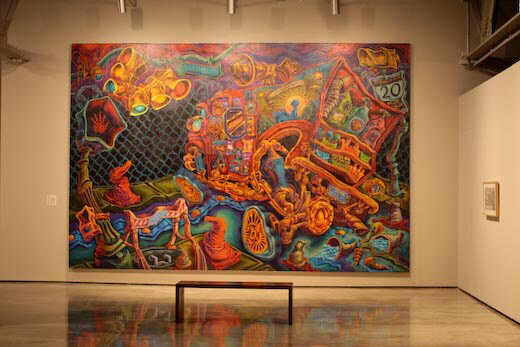
The Museo Alameda’s exhibit, curated by Benito Huerta, has a different goal: to juxtapose the work of two San Antonio artists with common yet divergent paths. The reason this show works is that the cinematic drama of Vincent Valdez’s work provides an effective counterpoint to the twisted, psychedelic visions of Alex Rubio. Both artists embrace the gritty reality of the streets in their native barrios, and bring into full view both the pride and the laments of their cultural heritage. Yet the divergent means through which they approach these realities tinges the community they depict with two distinct flavors. Valdez’s aesthetic could be drawn from the films of Scorsese, with their visceral impact and complex, yet direct, realism. At the same time, Valdez weaves a contemporary symbolism into his work, imbuing it with a sense of cultural depth. Rubio, on the other hand, seems to owe more to the psychedelic exploration of underground comics or even rock concert posters, while bringing this stylistic vocabulary to a new level of complexity and vibrant energy.


But when your eye drifts from the paintings, the rough edges start to become apparent. A huge map of San Antonio reminiscent of a pirate treasure map is prominently installed in the exhibit, highlighting the artists’ neighborhoods and showing the locations of significant events in their lives. Besides being difficult to read, this map, when at long last it is deciphered, brings very little to the paintings, which clearly convey a coherent experience of the world. Neon hands designed by Valdez forming the “signs” for the North, South, East and West sides feel tacked on; and a sculpture of the boxer in Valdez’s paintings lacks the emotional depth and formal strength of the original.
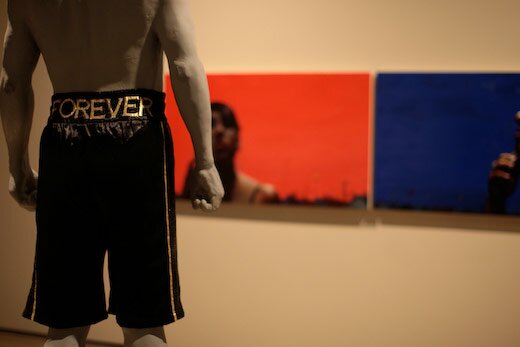
Still, this show is about the paintings, and the paintings succeed.
Posted by ben on 08 Dec 2007 | Tagged as: essays, music, r.i.p., responses/reviews, sound art
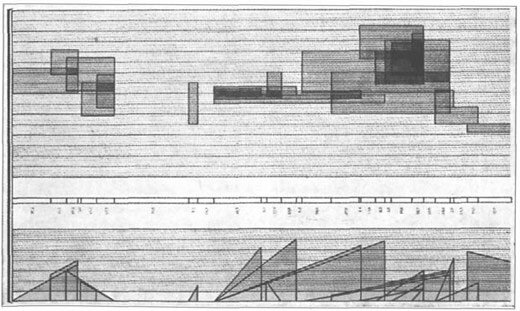
On the news of Stockhausen’s death, it may be worth reading this long essay on his work, which is still often misunderstood. This brief quote encapsulates some of the main ideas of the essay (by Jean-Claude Eloy):
The splendid success of the overall conception, general organization and production of “Zyklus” still do not always allow for the percussions to truly express their life and demonstrate all of their rich potential. On this matter, a work such as “Mikrophonie I” opens up surprising vistas and breaks down all barriers. The rich, but single, source for the whole work (the large tam-tam) is allowed ample time to “share” its multiple metamorphoses of tones, attacks, and resonances. Once again, with such a work, Stockhausen has shown himself to be a frontrunner, the boldest of all.
Throughout his work, Stockhausen’s dialectical personality is express by this double thrust, one rotating, the other ascending. One the one hand, he is truly audacious in his conceptual work and he knows how to impose a (sometimes “abstract”) form of thinking on musical material. And on the other hand, he possesses a very open sensitivity that studies material, listens to sounds created in the studio, analyzes their hidden pulsations, all to extract new meaning, go a step further and push the material forward.
Stockhausen’s double success in the two worlds of instrumental and vocal music – sound material that is already laden with history and acquired habits – as in the new realm of exploration of electro-acoustic technologies (a unique case in our times), can be understood by the presence of this dialectic that is constantly criss-crossing and circulating between two poles: from conception to material and from material to conception. Although ostensibly contradictory, these two poles are, in fact, complementary.
[Image above is a page from the score of Stockhausen's 1954 composition Studie II]
UPDATE: I decided to upload an MP3 of Stockhausen’s groundbreaking 1956 composition, Gesang der Junglinge. You can read more about this piece here. Enjoy.
Posted by ben on 06 Dec 2007 | Tagged as: borders, interviews, responses/reviews

This 1993 article / interview from Art in America about Richard Prince’s use of images of women deals with some important issues, including perception, appropriation, and feminism.
BW: You’re talking about the humor of the jokes, but a lot of them are incredibly hostile as well.
RP: Yeah. The comedians that I’ve met are certainly not the happiest people in the world. But that’s not really what I’m about, this kind of hostility or anger or tragedy. l’m mostly thinking in a very boring way. It’s really about going into the studio every day and working, so many of my concerns are really formal, straight-out, boring problem solving.
BW: I guess what I’m leading up to is that a lot of women think that your anger is directed at women.
RP: I like women. I have no problem with women. I’ve heard this and it upsets me to a point, but actually I think it’s a rumor. I know lots of women who like my work and understand it. I think that’s a generalization. There’s nothing directed against women.
BW: Maybe you could talk about another series that enraged a lot of women: the so-called biker chicks.
RP: Well, as far as the biker chicks are concerned, I just wouldn’t mind being one. I’ve never said that before, but I think that’s what I really feel. There’s a certain kind of desire and a certain amount of passion. I like what I think they look like, or perhaps what they are. I think many of these pictures have their own egos and they have an imagination of their own. That’s my own particular reaction. I also think the biker chick is perhaps a more realistic representation than the Grace Kelly girl-next-door. I mean, the biker chicks are the girls next door. The title of the series, “Girlfriends,” is a nonfiction title; those girls are girlfriends. The pictures are taken by their boyfriends and published in a magazine. It’s not like a cult or anything. There are four or five of these large-scale, mass-market publications. Maybe I like women like that.
Posted by ben on 06 Dec 2007 | Tagged as: arts organizations, responses/reviews
Joe Solis’ recent article in the Current critiquing the Museo Alameda has a number of problems, although I agree with the general sentiment that the Museo needs to improve its curatorial work and engage with a broader spectrum of San Antonio’s Latino (and non-Latino) community. Two recent developments give me hope that the Museo leadership is starting to realize the importance of these goals.
First, the initiation of a “free day” (with outside funding) will encourage the lower-income segments of the community to explore what the Museo has to offer. Oddly, Solis takes umbrage at this free admission day, calling it a “bribe”. He cites the popularity of other local museums to show that the Alameda doesn’t need to allow free admission — but he completely ignores the fact that two of the three museums he cites also have “free days”, and that it is a standard practice in the museum industry. He’s right that this isn’t going to solve all the museums outreach problems, but it is certainly a step in the right direction.
On the curatorial end of things, the Museo has finally put together a show I’m genuinely interested in seeing. Alex Rubio and Vincent Valdez, two well-respected local artists, will be sharing the museum for an exhibition called “Pride of the Southside: En el Mero Hueso”. This show should certainly bring out the art community in droves (Rubio’s recent show at Artpace was packed), and should also be the kind of work that a broader audience can connect with. It should even entice those people alienated by recent Alameda shows that politicized Day of the Dead and anglicized the huipil. Solis doesn’t even mention this exhibit, which opens next week, in his article.
Again, any real solution to the lack of outreach and weak programming will have to involve deeper changes in the Museo, but I’m seeing some encouraging developments at “the pink lady on Commerce” (as Solis calls it), which I hope are indicative of a more meaningful long-term strategy and a shift in the administrative culture (this will be the key).
P.S. Note to Joe Solis — the Museo Alameda is not a “division of the Smithsonian Museum”, not by a long shot. The Museo Alameda is a Smithsonian Affiliate, along with many other museums around the country. The Current should run a correction.
UPDATE: I just learned that the Museo Alameda pulled an ad from the Current due to Solis’ article. The ad was for the upcoming Alex Rubio / Vincent Valdez exhibit. If the leadership at the Museo thinks this is the best way to address criticism from the media, then it is clearly working against the organization’s own stated mission. The Museo was apparently built to encourage dialogue between cultures, but as soon as a discussion about the efficacy of the organization begins, the folks at the Alameda try to shut it down. Solis rightly identified a deficit in the Museo’s outreach efforts; in response they damage that very outreach effort in an act of petty retaliation. This mindset, if it continues, is going to doom the museum and ultimately damage the community it is apparently trying to enrich. This isn’t about whose “team” we’re on; it’s about working together as a community towards mutual understanding and respect. If the Alameda wants to shut down dialogue, then they do so at their own risk. Currently the conventional wisdom in the arts community is decidedly critical of the museum; even if the Museo is able to blackmail every media source into silence, that won’t change a thing.
UPDATE 2: The Current has also covered the Alameda in the context of their city funding, and Chairman Henry Muñoz’s involvement with the city-funded Luminaria arts night. This is, I think, a more sensible and well-researched piece. It also has a fabulous photo of Muñoz.
Posted by ben on 03 Dec 2007 | Tagged as: books, design, essays, responses/reviews
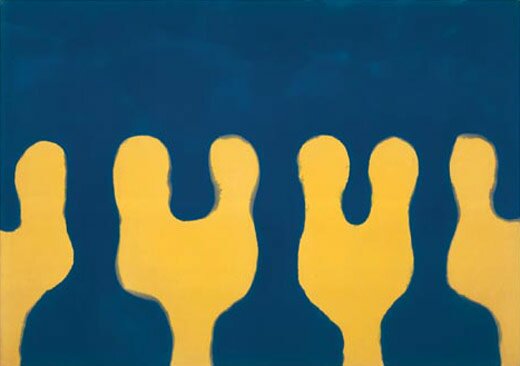
I just got an email asking why we hadn’t covered the Paul Feeley show currently on exhibit at Lawrence Markey, and my excuse was that I’m not good at writing about that kind of art. However, it’s an impressive show, and deserves more attention. So I decided to quote from a catalog / book of Feeley’s work put out by Matthew Marks and Lawrence Markey back in 2002. This passage is from a short essay about Feeley written by Lane Relyea. is definitely worth picking up if you are interested in Feeley’s work. I’ll also take this opportunity to scold our San Antonio readers for not attending Lawrence Markey’s openings with more consistency (you know who you are) — he consistently puts together great shows by important artists.
Feeley’s paintings from the ’60s betray too much of High Modernism’s earnest optimism to be characterized as primarily subversive, and yet it’s also hard to see them as bent on autonomy. With their extendable patterns of simple, interlocking forms and their nondeclarative quality gained by the back-and-forth play of assertive and recessive shapes, they’re too suggestive of tiles, fabrics, and other such prosaic materials. These references might in turn place Feeley’s art within [Constructivism], except that there’s no mistaking Feeley for a harbinger of revolution. Feeley’s mature work seems to bear the influence of postwar industrial and commercial design and the intense interest paid to it by college art curricula, lifestyle magazines, and museum curating (including the series of “Good Design” shows MoMA mounted in the early ’50s). In Feeley, as in all these instances, the attempt to merge art and life was made without any nervous glancing at the clock of revolutionary history. Historical time-keeping was also a prominent feature of Modernist painting as Clement Greenberg conceived it, which may help to explain why the critic’s support for Feeley was only lukewarm. Paintings were less likely to participate in grand historical advances if they nestled too comfortably in the private spaces of home and daily social life, where history loses sight of its main actors and staging grounds, its leaders and elections and wars, and instead moves almost imperceptibly.
Posted by ben on 02 Dec 2007 | Tagged as: responses/reviews, video/film
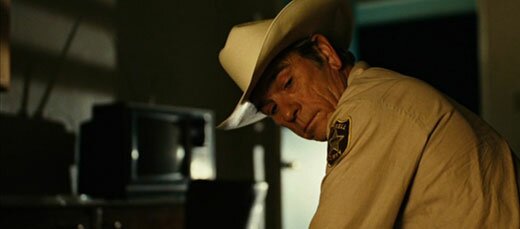
A friend pointed me to this excellent analysis of the end of the new Coen brothers movie (obviously, there are spoilers) by film critic Glenn Kenny. Kenny does a good job of pointing out divergences from the novel on which the film is based in order to pinpoint the significance of the Coens’ ending. He also does a fine job of putting the final scene into historical context. And for good measure, here’s a rebuttal from Alicublog. I tend to side with Kenny on this one (who apparently considers the film a masterpiece), although I’ll have to see it again before taking a strong position. Throughout the work the Coens refuse to show you what you want to see, ultimately transforming a thriller into an elegy. The question of whether this is a great film hangs on whether the transformation is successful, or is an overreach, an unraveling. That question’s not so easy to answer on just one viewing.